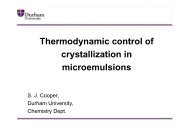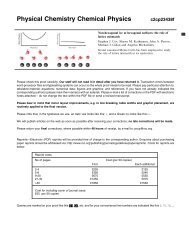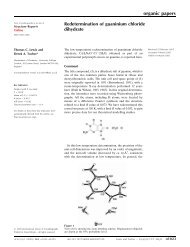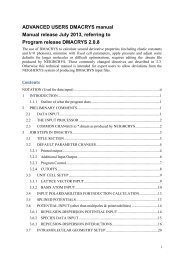An Introduction to the Theory of Crystalline Elemental Solids and ...
An Introduction to the Theory of Crystalline Elemental Solids and ...
An Introduction to the Theory of Crystalline Elemental Solids and ...
Create successful ePaper yourself
Turn your PDF publications into a flip-book with our unique Google optimized e-Paper software.
48<br />
[15] W. Kohn <strong>and</strong> L. Sham, Phys. Rev. 140, 1133 (1965).<br />
[16] This may also be called “Pauli correlation” because it correlates <strong>the</strong> dynamics <strong>of</strong> electrons<br />
<strong>of</strong> like spin. Obviously electrons also repel each o<strong>the</strong>r because <strong>of</strong> <strong>the</strong>ir charge.<br />
[17] A distinction between “empirical” <strong>and</strong> “non-empirical” DFT functionals is also common.<br />
Empirical in this context covers those functionals that are designed in order <strong>to</strong> reproduce<br />
experimental results or <strong>the</strong> results <strong>of</strong> high-level quantum chemical calculations for quantities<br />
such as a<strong>to</strong>mization energies <strong>and</strong> bond lengths. Typically “training sets” comprised <strong>of</strong> a<br />
large number <strong>of</strong> well-defined energies <strong>and</strong> structures <strong>of</strong> small gas phase molecules are used<br />
when making this comparison. The o<strong>the</strong>r essentially opposing, non-empirical, strategy is<br />
<strong>to</strong> design functionals that abide by a number <strong>of</strong> well-known physical constraints which <strong>the</strong><br />
exact E xc functional should obey <strong>and</strong> do not include parameters o<strong>the</strong>r than fundamental<br />
constants.<br />
[18] M. Gell-man <strong>and</strong> K. A. Brueckner, Phys. Rev. 106, 364 (1957).<br />
[19] D. M. Ceperley <strong>and</strong> B. J. Alder, Phys. Rev. Lett 45, 566 (1980).<br />
[20] J. P. Perdew <strong>and</strong> A. Zunger, Phys. Rev. B 23, 5048 (1981).<br />
[21] J. P. Perdew <strong>and</strong> J. Yang, Phys. Rev. B 45, 13244 (1992).<br />
[22] S. J. Vosko, L. Wilk, <strong>and</strong> M. Nusair, Can. J. Phys. 58, 1200 (1980).<br />
[23] A note on <strong>the</strong> nomenclature behind DFT functionals may be appropriate. Functionals are<br />
most <strong>of</strong>ten named after <strong>the</strong>ir authors’ in such a way that <strong>the</strong> name “PBE” comes from a<br />
paper by Perdew, Burke, <strong>and</strong> Ernzerh<strong>of</strong>. Occasionally <strong>the</strong> year <strong>the</strong> paper was published<br />
is appended. <strong>An</strong>d if <strong>the</strong> functional is one <strong>of</strong> <strong>the</strong> so-called hydrid functionals, discussed<br />
in section 3.2(c) it is common <strong>to</strong> add <strong>the</strong> number <strong>of</strong> parameters used when mixing <strong>the</strong><br />
Hartree-Fock exchange with <strong>the</strong> DFT exchange <strong>and</strong> correlation. For example, PBE0, is a<br />
hybrid functional with zero mixing parameters.<br />
[24] O. Gunnarsson <strong>and</strong> B. I. Lundqvist, Phys. Rev. B 13, 4274 (1976).<br />
[25] O. Gunnarsson, M. Jonson, <strong>and</strong> B. I. Lundqvist, Solid State Commun. 24, 765 (1977).<br />
[26] T. Ziegler, A. Rauk, <strong>and</strong> E. J. Baerends, Theor Chim. Acta 43, 261 (1977).<br />
[27] K. Burke, J. P. Perdew, <strong>and</strong> M. Ernzerh<strong>of</strong>, J. Chem. Phys. 109, 3760 (1998).<br />
[28] J. P. Perdew, K. Burke, <strong>and</strong> M. Ernzerh<strong>of</strong>, Phys. Rev. Lett. 77, 3865 (1996).<br />
[29] PBE <strong>and</strong> its <strong>of</strong>f-spring differ only in how <strong>the</strong>y treat electron exchange. The exchange<br />
component <strong>of</strong> GGA-PBE is<br />
∫<br />
E P BE<br />
x [n] =<br />
nɛ xc−unif (n(r)) Fx<br />
P BE (n, ∇n(r)) d 3 r<br />
where F P BE<br />
x<br />
is an exchange enhancement fac<strong>to</strong>r given by<br />
Fx<br />
P BE<br />
κ<br />
[n, ∇n(r)] = 1 + κ −<br />
1 + µs 2 /κ<br />
with <strong>the</strong> dimensionless reduced gradient, s = |∇n|/2n(3π 2 n) 1/3 . In <strong>the</strong> original PBE κ =<br />
0.804. In revPBE κ = 1.245. In RPBE F x [n, ∇n(r)] = 1 + κ − κexp(−µs 2 /κ), <strong>and</strong> in<br />
PBE-WC µs 2 takes a more complex form.<br />
[30] Y. Zhang <strong>and</strong> W. Yang, Phys. Rev. Lett. 80, 890 (1998).<br />
[31] B. Hammer, L. B. Hansen, <strong>and</strong> J. K. Nørskov, Phys. Rev. B 59, 7413 (1999).<br />
[32] Z. Wu <strong>and</strong> R. E. Cohen, Phys. Rev. B 73, 235116 (2006).<br />
[33] J. Tao, J. P. Perdew, V. N. Staroverov, <strong>and</strong> G. E. Scuseria, Phys. Rev. Lett. 91, 146401<br />
(2003).<br />
[34] The philosophy behind <strong>the</strong> hybrid functionals is simple <strong>and</strong> rooted in <strong>the</strong> adiabatic connection<br />
formula, which is a rigorous ab initio formula for <strong>the</strong> exchange-correlation energy







